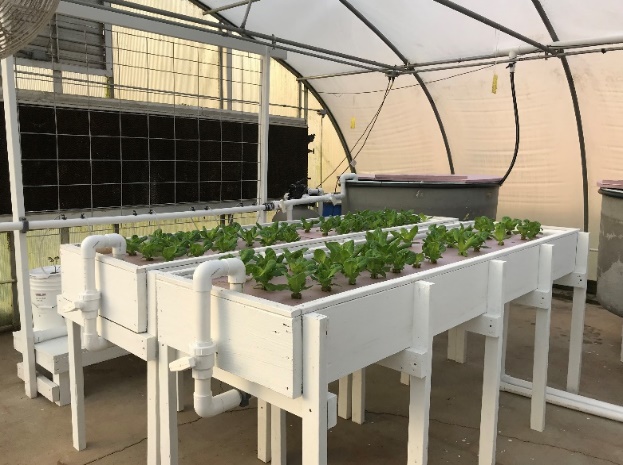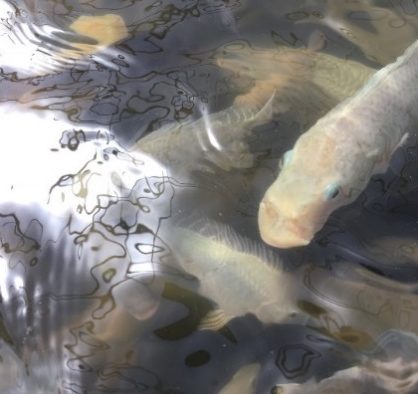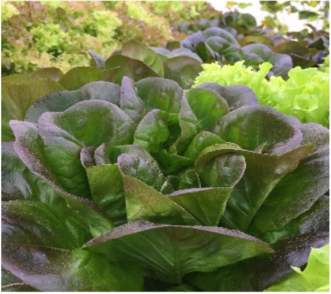Alternative ways to grow healthy fresh food are being discovered by households and small farmers due to space and resource limitations. One alternative food-production method gaining in popularity is aquaponics. Aquaponic production allows families to grow fresh produce and provide a healthy protein in a small area suitable for most backyards. It also allows small farmers to diversify their production and offer alternative foods at local farmers’ markets or other outlets. This article provides a general introduction to aquaponics with basic information about system components, fish and plant selection, and management techniques for water quality and the everyday operation of the system.
What is Aquaponics?
Aquaponics is the combined culture of fish and plants in recirculating aquaculture systems. Nutrients, which are excreted by the fish or generated by the microbial breakdown of organic wastes, are taken up by plants cultured hydroponically.1 Aquaponics was introduced through the recirculating aquaculture community to enhance water treatment.2,3,4 An aquaponics system utilizes plant systems to reduce excess nutrient loading. By recirculating water within the system, the reduction of water usage for growing food is reduced considerably, making the system very efficient. Aquaponics has two other advantages: the small amount of space needed for production because food can be grown vertically and horizontally and the ability to enclose an aquaponics system in a greenhouse that offers year-round production minimizes damage from pests. Aquaponic systems are typically located in a greenhouse or warehouse where temperature can be more reliably controlled. Aquaponics has grown in popularity in many regions throughout the United States and will continue to become a sustainable method for growing leafy greens (e.g., lettuce, kale, herbs) and fruiting crops (e.g., tomatoes, cucumbers, squash). Aquaponic production is a sustainable alternative to more conventional crop production practices that deplete aquifers of water and soils of nutrients and organic matter.
Aquaponics System
An aquaponics system consists of both fish and plant growing tanks, with both production areas contributing to the overall benefits of the system as a whole (figure 1). The provision of ample space for the fish to grow is critical for successful production. A well-designed fish system delivers water movement and adequate aeration for proper environmental conditions for the fish to thrive. The most important part of the fish system is filtration. Water filtration in an aquaponics system is twofold as the first sequence is clarifying the water by screening out any particles (fish food or feces) found in the water column. The second sequence in water filtration is biological, which provides beneficial nitrifying bacteria to convert ammonia to nitrate, which is essential for plant growth. The system is considered a closed recirculating aquatic system. Fouled water is transported from the fish system through waste transforming filtration, which delivers nutrient-rich water to plants before finally sending clean water back to the fish system to complete the cycle.

Figure 1. Aquaponics system including a fish tank, plant system, and filtration. Image credit: Lance Beecher, Clemson University.
The plant system, selected based on owner requirements, offers both positive and negative attributes for production. Designs for plant systems include “deep well” or “floating raft” systems, media bed, “ebb and flow” systems, or “Dutch bucket” or “bucket” systems. Most aquaponic plans can include a single plant growing system or a variety of approaches. The choice usually involves vegetable selection and space available for system operation. Commercial applications typically use a “deep well” or “floating raft” system to ease maintenance and cleanliness. Proper aeration and water circulation are critical for efficient operation. Careful attention is needed when designing the aquaponics system for optimum performance.
Fish Selection

Figure 2. Tilapia swimming in an aquaponics system. Image credit: Lance Beecher, Clemson University.
Fish selection depends upon operation location, the sensitivity of both fish and plants to water quality constituents, and finally, if the fish are grown for consumption as food or personal enjoyment. An assortment of fish species can be grown successfully in an aquaponics system. Foodfish (fish consumed for food) include warm water species such as tilapia (Oreochromis niloticus) (figure 2), channel catfish (Ictalurus punctatus), bluegill (Lepomis macrochirus), and hybrid striped bass (Morone saxatilis ´ Morone chrysops). If fish are grown for personal enjoyment, goldfish (Carassius auratus) or koi (Cyprinus rubrofuscus) are excellent choices because of the allure they offer when displayed in an aquaponics system. When choosing fish to cultivate in an aquaponics system for food, consider fish characterized by fast growth, prolific breeding habits, and the ability to withstand fluctuating environmental conditions. Consideration should include fish that can be held at high densities and easily accept commercial fish food. The fish need to be happy and healthy because they are the nutrient source for the aquaponics system.
Plant Selection

Figure 3. Lettuce varieties in a deep-water plant system. Image credit: Lance Beecher, Clemson University.
What plants can you grow? Given the system configuration and consistent input and balance of nutrients, aquaponics systems successfully cultivate plants. Plant selection, based on personal choice, is unlimited. However, there are some limitations to production; for example, most tubers or any crop that is cultivated underground in conventional growing techniques cannot be grown successfully in an aquaponics system. Leafy greens and lettuces (figure 3) are grown successfully in an aquaponics system. The raft system is a common choice for these groups, but cultivation is possible in any plant systems described above. Other vegetable selections, including fruiting plants such as tomatoes, are mainly grown in media beds or bucket systems and require higher fish biomass to produce the nutrients needed for fruiting plants. Experience with the operation of the aquaponics system is critical when selecting fruiting crops or crops with longer growing cycles before harvest.
References Cited
- Rakocy, James E.; Bailey, Donald S. Update on tilapia and vegetable production in the UVI aquaponic system. University of the Virgin Islands Agricultural Experiment Station. March 2011.
- Lewis WM, Yopp JH, Schramm Jr HL, Brandenburg AM. Use of hydroponics to maintain quality of recirculated water in a fish culture system. Transactions of the American Fisheries Society. 1978 Jan 1;107(1):9299.
- Naegel LC. Combined production of fish and plants in recirculating water. Aquaculture. 1977 Jan;10(1):1724.
- Rakocy JE, Masser MP, Losordo M. Recirculating aquaculture tank production systems: aquaponics – integrating fish and plant culture. Stoneville (MS): Southern Regional Aquaculture Center (SRAC); 2006. SRAC Publication No. 454.
- Sneed K, Allen K, Ellis JE. Fish farming and hydroponics. Aquaculture and the fish farmer. 1975;1(1):11–18.
- Clemson University Cooperative Extension Service offers its programs to people of all ages, regardless of race, color, gender, religion, national origin, disability, political beliefs, sexual orientation, gender identity, marital or family status and is an equal opportunity employer.

